The results of the specialists’ and scientists’ researches. Рубрика в журнале - Nanotechnologies in Construction: A Scientific Internet-Journal

Статья научная
Introduction. Existing automated construction inspection technologies do not allow the user to select the level of detail. At the same time, in the context of the use of nanotechnology, there is a growing need to expand the capabilities of monitoring and control of construction projects. The aim of the research is to develop, implement software, and validate a technology for controlling the speed and accuracy of constructing three-dimensional models from dense point clouds for automated monitoring of construction works. Materials and methods. The research is based on the methodology of non-binary data trees, including the method of constructing octant trees. An unmanned aerial vehicle with an aerial laser scanner, a ground-based scanning total station, and specialized software were used, including the web application “Management System for Monitoring Construction Works on Objects that have undergone state expertise” developed with the participation of the authors. Results and discussion. In the course of the study, a technology was developed and implemented in software that allows the user to select the required balance between accuracy, degree of detail of monitoring and control data for construction work and time costs and computing power requirements. The comparison is made between a construction project, presented in the form of a building information model, and a three-dimensional model of a real object, obtained from a dense point cloud. The degree of comparison accuracy is set by choosing the level of octrees used. By default, the web application uses level eight. However, in the early stages of construction, when the geometric parameters of a dense point cloud deviate significantly from the design boundaries, the ninth, tenth and other levels can be used. In this case, the accuracy and degree of detail increases. Positive and negative deviations are visualized in red and blue colors, respectively, which allows the user to monitor and control the progress of work at the site. Conclusions. The developed technology can be used by customers and other decision makers to control and monitor work.
Бесплатно
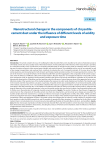
Статья научная
Introduction. The article considers the issue of modifying the initial chrysotile fiber and its bundles by the action of hydration products of Portland cement and various acidity value of the treated medium. A brief justification of the relevance of the research topic is provided. It is noted that recently, issues of production of composite materials based on natural and man-made raw materials, which are a promising area of modern economics, have aroused great scientific and practical interest. The availability and low cost of raw materials, as well as low energy, transportation, and overhead costs, contribute to reducing the cost of composite materials. At the same time, the high contractual prices and strong demand in both domestic and foreign markets provide incentives for increasing production volumes. The aim of the research is to study the behavior of the initial chrysotile fibers and their aggregates in the composition of the cement component under the influence of different acidity of the treated medium. Research objective: to investigate the behavior of chrysotile cement dust components under an aggressive environmental condition with electron microscopy examination; calculation of the number and dimensional characteristics of nanofibers and dust particles under the influence of various exposure times of the aggressive factor; microdifraction studies of the nanostructure of the studied samples after exposure to acidic media. Materials and methods. The materials used in the research and their characteristics are given, in particular, chrysotile cement dust containing fibers of commercial chrysotile, acidity of the medium, exposure time, micro- and nanofibers obtained after exposure to aggressive medium. Samples of chrysotile cement dust were taken at the slate production No.1 of JSC “BelACI” and collected at the place of sawing of chrysotile cement products, underwent the stage of dispersion using a centrifugal separator. In the work chrysotile cement dust was used as an object of environmental pollution and its further use in the production of composite chrysotile cement products. Results. The results of studies on the influence of aggressive environment on the components of chrysotile-cement dust, their size characteristics, and structural nano-changes are presented. The studied samples have been examined in a scanning ion-electron microscope at magnifications of 200x, 500x, 5000x, 10000x, and their chemical composition have been analyzed. Discussion. The results of analysis of the obtained experimental data are given. Quantitative composition of fibers and aggregates of fibers in chrysotile cement dust changes after its exposure in acidic medium in comparison with their quantity in initial chrysotile cement dust, and the quantity of separate thin fibers increases, it is explained by the fact that in acidic medium there is not only destruction of cement stone, but also splitting of bundles of chrysotile fibers into micro- and nanofibers. Conclusions. Electron microscopic examination of initial commercial chrysotile fibers and their bundles in cement dust have shown changes in their dimensional and quantitative characteristics, including the products of Portland cement hydration under the influence of the factor of aggressiveness of the environment.
Бесплатно

Статья научная
Introduction. Currently, the development of photocatalytically active cement-based materials with self-cleaning properties is a promising area of building materials science. Self-cleaning concrete is obtained by using photocatalytic additives, of which titanium dioxide (TiO2) is the most common. It has been found that the functional properties of TiO2 depend largely on its phase composition. This study aimed to establish the patterns of influence of phase composition on the photocatalytic activity of titanium dioxide under the impact of artificial ultraviolet and natural solar radiation and to identify the most effective titanium oxide-based photocatalysts for subsequent use in the composition of self-cleaning concrete. Methods and materials. Four titanium dioxide samples, namely two industrial samples and two samples synthesized by hydrolysis of titanium alkoxide in acidified water-alcoholic medium followed by calcination at 500 °C, were the objects of the study. X-ray powder diffractometry was the method used to investigate the structure parameters of TiO2 samples. The model reaction of oxidative degradation of methylene blue under UV- and daylight exposure was the means for studying the photocatalytic activity of titanium dioxide samples. Results and discussion. It was found that polymorphic modifications of titanium dioxide had a multidirectional effect on its functional characteristics, in particular, a rise in the content of anatase and rutile led to an increase and decrease in the photoactivity of TiO2 samples, respectively. The single-phase sample with anatase structure was most effective under UV irradiation, while the three-phase sample with the anatase : brookite : rutile ratio of 67% : 13% : 20% had the highest activity under daylight exposure. The photocatalyst composition, including several polymorphs of TiO2 with a predominance of anatase form (more than 50%), allowed to achieve a synergistic effect of increasing the photocatalytic activity of titanium dioxide under conditions of solar radiation due to the formation of type-II semiconductor heterojunctions. Heterostructures made it possible to improve the spatial separation of charge carriers and to reduce the recombination rate of photogenerated electron-hole pairs. Conclusion. The obtained results indicated the possibility of improving the functional characteristics of titanium oxide-based additives for self-cleaning concrete due to the targeted regulation of their phase composition by optimizing the synthesis parameters of photocatalytic modifiers.
Бесплатно
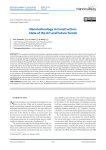
Nanotechnology in Construction: State of the Art and Future Trends
Статья научная
The construction industry has long been regarded asenergy-intensive and high pollution industry. The emergence of nanotechnology provides an ideal solution for the construction industry to energy saving and consumption reduction. The introduction of nanotechnology has greatly promoted the development of new green building materials and brought huge economic and social benefits. This paper applies bibliometric analysis to review the nanotechnology-construction research collected by Web of Science database during 2000–2020, and further visualize their literature characteristics. At the global level, the number of literatures on nanotechnology-construction research has been on the rise in 2000-2019, although it has experienced a small decline in individual years. At the national level, the United States has become the global leader in nanotechnology-construction research with 63 articles, far more than other countries. Considering the income gap, developed countries play an indispensable role in the global nanotechnology-construction research system, while the role of developing countries is relatively weak. We found that the existing nanotechnology-construction research mainly focused on the fields of chemistry and materials science. According to the frequency of keywords, the research focus of nanotechnology-construction research mainly focused on the development and application of new building materials. It is concluded that with the extensive attention of researchers, the future research on nanotechnology-construction will continue to appear and increase at increasing rate.
Бесплатно

Ni-SiC composite coating obtained by electrodeposition
Статья научная
Introduction. One of the common types of coatings is a composite coating based on nickel reinforced with solid particles of silicon carbide SiC. It has high anti-wear properties and is widely used to increase the strength of the working surfaces of internal combustion engine cylinders. The basic technology for applying the coating is electrodeposition. The quality of the coating is affected by the size of the solid particles. Difficulties in forming a composite arise when moving to a large fraction of 20–25 μm, especially when moving from flat samples to long axisymmetric parts. The aim of the research is to study the technological potential of creating a Ni-SiC coating on flat samples simulating a sector of an axisymmetric part. Methods and materials. The research part of the work was carried out on samples of aluminum alloy AK7. Electrodeposition mode: current density 10 A/dm2; duration 60 minutes; temperature 60 °С. The microstructure of the coatings was studied using an Olympus GX51 optical microscope. Coating wear resistance tests were performed using a CSM Micro-Scratch Tester. Microhardness was assessed using a DuraScan 50 microhardness tester. Roughness Ra was determined using a Mitutoyo Surftest profilometer. Results and discussion. The article considers the features of the process of forming a composite coating based on Ni-SiC by the electrodeposition method. A model of the action of electrostatic, gravitational and centrifugal forces on SiC particles in the electrolyte solution for electrodeposition is presented. Based on the model, an installation was designed, on which the technological process of applying a composite Ni-SiC coating to flat samples of aluminum alloy AK7, simulating a sector of an axisymmetric part, was successfully tested. Due to the possibility of rotating the installation during the electrodeposition, three types of coating were obtained: nickel-based «Ni»; nickel-based with silicon carbide particles ”Ni-SiC”; layered coating. Conclusion. The nickel coating with a uniform distribution of SiC particles is characterized by the maximum microhardness value, increased roughness and a small groove width after the scratch test, which indicates good adhesion to the substrate material.
Бесплатно
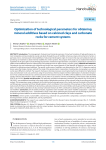
Статья научная
Introduction. The management of physical and chemical processes of structure formation of high performance cement composites can be provided at several scale levels through the use of modifiers of various nature and mechanism of action, in particular, micro- and nanoscale mineral additives of natural and technogenic origin. It is known that clays and carbonate rocks are promising raw materials to obtain mineral modifiers for cement systems. The purpose of this study was to establish the influence regularities of the prescription and technological parameters (material and granulometric compositions, temperature calcination) to obtain mineral additives based on calcined clays and carbonate rocks on their activity in cement systems. Methods and materials. Polymineral clays and carbonate rocks (dolomite and chalk) from several deposits of the Republic of Mordovia were used as raw materials for obtaining mineral additives. The specific surface area of modifiers was determined on the PSX-12 dispersion analysis device using the Kozeny-Carman method. The study of the granulometric composition of sedimentary rock powders was carried out by laser diffraction method. The research of physical-chemical processes occurring during the heat treatment of polymineral clays and carbonate rocks was carried out using the synchronous thermal analysis method. Optimization of calcination temperature of clay-carbonate mixtures was carried out based on the research results on the effect of their additives on the cement binder activity with the determination of the modifier activity index in accordance with the methodology of the Russian State Standard GOST R 56178-2014. Results and discussion. The optimum calcination temperature, located for polymineral clays in the area of 500–800оC, was established according to the study results of dehydration processes of clay minerals using the synchronous thermal analysis. This temperature range corresponds to the initial restructuring processes in the crystal structure of minerals of the kaolinite and illite groups, associated with their dehydroxylation, which contributes to the transition of these phases to the active form. The study results of influence of additives of calcined clay-carbonate mixtures on the cement binder activity proved the thermal analysis data. It was found that calcination of clays and clay-carbonate mixtures at 700°C contributes to obtaining of the most effective mineral modifiers. Conclusions. On the totality of studies, regularities were revealed in the system “modifier composition – calcination temperature of sedimentary rocks – mixed binder activity”, which allow optimizing the prescription and technological parameters for obtaining mineral additives to achieve the required level of strength characteristics of cement composites.
Бесплатно
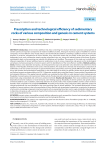
Статья научная
Introduction. Active mineral additives that allow controlling the structure formation processes and properties of cement systems are important components of modern modified concretes. Among the numerous types of modifiers for cement composites, the most effective ones include siliceous and aluminosilicate additives containing a significant amount of nanoscale particles, in particular, nanoparticles of silicon dioxides, clays, aluminum oxides and iron oxides. At the same time, common sedimentary rocks, such as diatomites, trepels, opokas, polymineral clays, etc., along with industrial wastes (silica fumes, fly ashes, metallurgical slags) can be promising raw materials for obtaining such modifiers. The purpose of this study was to establish the influence regularities of mineral additives based on sedimentary rocks of various composition and genesis on the technological and physico-mechanical properties of cement systems with the identification of the most effective modifiers. Methods and materials. Siliceous rocks (diatomite and opoka), calcined polymineral clays and carbonate rocks (dolomite and chalk) from several deposits of the Republic of Mordovia were used as mineral additives. The study of the chemical and mineralogical composition of sedimentary rocks was carried out using X-ray spectral fluorescence spectrometry and X-ray powder diffraction methods. In addition to the chemical and mineralogical composition, at the initial stage of the study, the specific surface area of mineral additives and Portland cement was determined on the PSX-12 dispersion analysis device using the Kozeny-Carman method. Prescription and technological efficiency of the applied mineral modifiers was evaluated by their effect on water demand, water-holding capacity, flowability of cement paste and mixed cement binder activity. The physical and mechanical characteristics of cement systems were determined using standardized and well-known authorial methods. Results and discussion. There were established correlation dependences between indicators of water demand, water-holding capacity, flowability of cement systems and specific surface of mineral additives used. In addition, relationship between the activity index of the studied modifiers and the content of silicon dioxide in their composition was revealed. Conclusions. According to the totality of the conducted studies, diatomite, opoka and calcined polymineral clay were identified as the most promising types of mineral additives. The increased effectiveness of these modifiers in cement systems is due to the peculiarities of their chemical and mineralogical composition, in particular, the presence of active silica-containing components (reactive minerals with an amorphized structure) such as opal-cristobalite-tridymite phase in diatomite and opoka as well as products of partial thermal destruction (dehydroxylation) of minerals of kaolinite and illite groups in the calcined polymineral clay.
Бесплатно
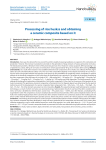
Processing of rice huskss and obtaining a ceramic composite based on it
Статья научная
Introduction. Every year, the demand for rice around the world is steadily increasing, leading to an expansion of its cultivation and production. However, this increase in production also leads to the generation of large amounts of waste, particularly rice huskss. The introduction provides a literature review of the processing and use of rice huskss for various purposes. When producing 1 ton of polished rice, about 200 kg of rice huskss is formed, from which approximately 40 kg of ash remains after burning. Methods and materials. As a result of the research it was established that the main components of rice huskss are: cellulose (40-45%), lignin (about 20–25%) and hemicellulose (about 15%). The rest of the composition depends on the deposit and variety of rice. Processing rice huskss using hydrocavitation and pyrolysis units opens up new possibilities for producing ceramic composites. A spectral analysis of the chemical composition of rice husks from the Suzak district was carried out. The results of the analysis showed that the main component of the solid mass of rice husks is SiO2 – 400 mg/kg, MnO – 195 mg/kg, K2O – 120 mg/kg, MgO – 30 mg/kg, CaO – 20 mg/kg, P – 13 mg/kg, Na2O – 3.9 mg/kg, Fe2O3 – 3 mg/kg, Ag – 0.04 mg/kg, and other impurities. The article presents a methodology for studying the composition and properties of rice huskss components. A flow chart for the process of fast pyrolysis of rice husks is presented. The preliminary chemical composition of bentonite from the Tegerek deposit was determined by the spectral method as part of the development of a ceramic composite. Main components: SiO₂ – 50%, Al₂O₃ – 12%, Fe₂O₃ – 12%, MgO – 4%, CaO – 3%, K₂O – 2%; other elements are present as minor impurities. Results. The experimental part used hydrodynamic cavitation technology, as a result of which rice huskss was processed using a hydrocavitator. Results: It was found that after cavitation treatment, rice husks is divided into three fractions: coarse mass – 75%, plastic mass – 15.83%, and a fine fraction, constituting 9.6%, suspended in water. The composition, structure and physical and technical characteristics of the coarse and plastic fractions of rice husks were studied. Rapid pyrolysis of the coarse fraction after cavitation treatment was carried out. Based on the resulting ash and silicon-carbon material formed during the pyrolysis process, dense and porous ceramics for various purposes were synthesized. Conclusion. A technology for processing rice huskss using the created hydrocavitator and the method of fast pyrolysis for obtaining a ceramic composite has been developed. A study has been conducted of the composition and structure of rice huskss after cavitation treatment, as well as solid residues formed as a result of fast pyrolysis. As a result, both dense (ρ = 1.19–1.22 g/cm³) and porous (ρ = 0.51–1.02 g/m³) ceramic composites based on processed rice husks were obtained using hydrocavitation and pyrolysis.
Бесплатно
Статья научная
Introduction. In the article we analysed the technology for producing silicon from rice husks. The analysis showed that the production of polycrystalline and amorphous silicon based on rice waste in the form of rice husk solves the simultaneous disposal of rice waste. Rice husk processing produces valuable organic products, and the residual solid waste mainly contains silicon, carbon and other trace metal elements. Therefore, obtaining silicon and silicon-containing materials from rice husk is relevant. Methods and materials. Various methods for obtaining silicon from rice husk are given. Among them, the methods of chlorination and sublimation were chosen, and experimental installations were assembled to conduct the experiment. The object of study was samples obtained from rice husks of Uzgen rice in the Kyrgyz Republic. Results. The composition and structure of rice husks for the production of crystalline silicon were studied. Lime milk was used to purify toxic chlorine-containing gases in the air of the working area and atmospheric air. The condensing system, designed to capture volatile chlorides, has two receivers. In the first receiver at a temperature of 60°C, condensation of iron, aluminum and magnesium chlorides occurs. It has been established that highly volatile silicon (IV) chloride (SiCl4) at a given temperature remains in the gaseous phase and is completely distilled off in the next receiver of the refrigerator. This indicates that the silicon is in the form of SiCl4 (60°C) and condenses only at a lower temperature in the next receiver. The data obtained indicate that when the temperature rises to 200°C, the process of chlorination of metal compounds initiates. The optimal conditions for maximum extraction of metals and silicon tetrachloride from rice husk were identified: temperature 500–550°C and time 120 minutes. Non-volatile chlorides of calcium, sodium, potassium and other elements form a floating mixture at 450°C. During the reaction, metal chlorides harden and settle on the cold walls of the reactor. Therefore, at this temperature there is not enough heat to maintain them in a gaseous state, and they condense to form solid precipitates. Lime milk containing CaO – 130 g/dm2 is a very effective and cheap means for purifying toxic chlorine-containing gases in the air of the working area and atmospheric air. At high temperatures (1050–1100°C), it is possible to activate chemical reactions between the carrier gas (hydrogen) and silicon chloride (SiCl4), which promotes the decomposition of SiCl4 into components, including silicon and hydrogen chloride, and also provides certain conditions for the formation and deposition silicon crystals. Conclusion. A technology for producing polycrystalline silicon by chlorination from rice husks of Uzgen rice of the Kyrgyz Republic has been studied and developed.
Бесплатно

Resource-saving nanotechnologies in waste water treatment
Статья научная
This paper examines the prospective field of nanotechnology development in the area of wastewater treatment and water processing. The introduction showed (no need for comma) that the Russian problem is not the lack of water – but its quality. Water treatment is needed to prevent water facilities from pollution. Self-cleaning methods cannot withstand the massive impact of pollutants, some of which are unknown for their natural reproduction processes. The degree of purification depends on the concentration of the pollution and the content of different substances within it. The use of nanotechnologies in effluent neutralization (EN) processes will allow removing insoluble sludges, wastes of chemical industry, and harmful microorganisms. Methods and materials. This work presently uses analytical methods to study nanotechnologies. Nanofiltration and membrane methods are frequently used in wastewater treatment. Methods such as arc charge, ablation, and gas-phase deposition are applied to obtain carbon nanotubes. Results. The authors describe promising carbon nanomaterials for production of membranes used in purification/decontamination/ desalination of water. The new generation of membranes for filtering, disinfection, and desalination have been shown. These include graphene and carbon nanotubes which present absolutely new nanomaterial. Discussion. It was revealed that such membranes are characterized not only by a high water percolation rate, but also by extraordinary selectivity. Such membranes are particularly promising in the field of biomedicine, as large membranes are necessary for the nanofiltration and desalination processes. Conclusions. This paper examines new ecological and resource-saving technologies making possible improved research, industrial and commercial activities (which by means of practical implementation of inventions will lead to improved products), technologies and organizational decisions. One of the most promising areas for the development of nanotechnologies applied in waste water treatment is the advancement of membrane technology employing innovative materials, specifically graphene and carbon nanotubes.
Бесплатно
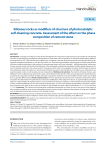
Статья научная
Introduction. Currently one of the focus areas for the development of construction material science is the creation of self-cleaning concretes characterized by polydisperse multicomponent composition with the presence of nanoscale photocatalytic additives, primarily based on TiO2. These photoactive modifiers give the material a number of positive properties, including the ability to decompose atmospheric pollutants, to self-clean the surface, etc. The promising method for improving the functional characteristics of titanium oxide photocatalysts is the creation of nanostructured systems with ‘core (substrate) – shell (photocatalyst)’ architecture. Previous research results show that the final efficiency of the synthesized composite photocatalytic modifiers largely depends on the level of substrate reactivity in the cement system. The purpose of this study is to investigate the impact of three types of siliceous rocks (diatomite, trepel, and opoka) on cement stone formation processes and to identify the most effective raw materials for use as photocatalytic carriers in self-cleaning concrete compositions. Methods and materials. The methods of Kozeny-Karman, laser diffraction and X-ray fluorescence spectrometry were used to determine the specific surface area and parameters of granulometric and chemical compositions of silicite samples. The phase composition of siliceous rocks and modified cement systems was studied by X-ray powder diffractometry. Results and discussion. The main parameters of granulometric composition of diatomite, trepel and opoka were determined. The predominance of reactive modifications of free silica (47.6–78.0 wt. %), represented by amorphous opal-A or cryptocrystalline OCT-phase (opal-CT), were revealed in the structure of silicites. It was found that increasing the dosages of silica-containing additives from 0 to 10% resulted in decreased by 10–27% in the quantity of portlandite in the phase composition of cement stone aged 28 days, while the content of high-strength low-basic calcium hydrosilicates (C–S–H (I)) increased by 11–27%. Conclusion. The chemical and mineralogical composition peculiarities of silicites, as well as the nature of the impact of silica-containing modifiers on the structure formation processes of cement systems, determine the prospects of using opal-cristobalite rocks as dispersed photocatalyst carriers for self-cleaning concrete.
Бесплатно
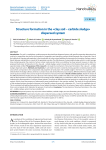
Structure formation in the «clay soil – carbide sludge» dispersed system
Статья научная
Introduction. Clay soil is a multiphase, multicomponent aluminosilicate dispersed system with specific properties determined not only by its composition but also by the formation of coagulative and transition contacts (binds) between the soil particles. One of the methods of changing soil properties is the introduction of active mineral additives that promote the formation of phase contacts (binds) between soil particles as a result of the pozzolanic reaction. The effectiveness of using carbide sludge, which is a multi-tonnage lime-containing waste (the content of active calcium oxide reaches 56%) as an additive, has been proved. However, to date, the proposed mechanism of interaction in the «clay soil – carbide sludge» system is based only on the literature data and has not been experimentally verified. The purpose of this research is to study the mechanism of structure formation in the «clay soil – carbide sludge» dispersed system. Methods and materials. A soil model has been created by mixing saponite-containing material with sand, which corresponds to the composition and properties of sandy loam. The carbide sludge in the form of a suspension was selected from the sludge collector, dried to a constant mass and sieved. Microstructural analysis, differential thermal analysis (DTA), and X-ray phase analysis were used to study the mechanism of structure formation. Results and discussions. Based the results of the differential thermal analysis, there is a decrease in the intensity of the endothermic effect in the range of 460 to 470°C associated with the decomposition of calcium hydroxide in the treated sample. Additionally, an endothermic effect is observed at 750°C, which indicating the decomposition of calcium silicate hydrate. The results of differential thermal analysis are confirmed by X-ray phase analysis, which shows the presence of tobermorite group hydrosilicates in the reaction medium. The study of the microstructure of the analyzed mixtures revealed a decrease in the specific volume of pores with a diameter of 4–5 nm in the modified clay soil. This is associated with gelling from particles of new hydrate formations. Besides that, the volume of pores with a diameter of more than 6 nm increased, which indicates the process of contraction. Conclusion. The mechanism of structure formation in the «clay soil – carbide sludge» system has been established.
Бесплатно
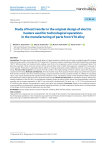
Статья научная
Introduction. This paper examines the original design of a high-temperature tubular electric heater cartridge designed for heating industrial tooling used in the production of VT6 alloy parts. The process requires maintaining stable high temperatures exceeding 1000 °C. Without proper heat treatment after welding, cracks form in the components, which can lead to subsequent failure. This becomes especially critical when the structure of the weld and base metal is highly heterogeneous, ranging from nanoscale to coarse-grained. Furthermore, undesirable thermal effects on tooling components require additional costs for cooling and monitoring. The aim of the research is to evaluate the heat transfer of the original design of electric heaters used in the production of parts from VT6 alloy. Methods and Materials. The heat transfer study of the proposed heater design was performed using the finite element method in the Ansys software package, using the Transient Thermal calculation module. To validate the calculated values, a test rig was developed that reproduced the simulation results. A qualitative analysis of the temperature fields confirmed the hypothesis of uniform operation of the proposed heater design. Results and discussion. A quantitative analysis reflected the heating conditions of the VT6 alloy. The temperature modeling results at tooling control points were experimentally confirmed, ensuring that the target temperature of 1000 °C was achieved in a localized zone. The error was ± ≈ 70 °C. The microstructure of VT6 titanium alloy samples was examined in various zones after heat treatment. Conclusion. Based on the conducted research, recommendations are proposed for selecting optimal operating conditions for high-temperature tubular electric cartridge heaters of this design, and their potential applications are described.
Бесплатно

Статья научная
Introduction. Literature analysis and patent search revealed that basalt rock and its fibers have exceptional physical and technical characteristics and alongside abundant raw material reserves. Based on this, the use of basalt rocks and their fibers as a material for the development of advance composite materials with high performance characteristics is a promising direction. Diverse technological fields and economic sectors, as well as various material requirements, necessitate a spectrum of systems, compositions, and properties for basalt and its melts, whether for generating superthin or continuous fibers. Methods and materials. The chemical and mineralogical compositions of some basalt rocks from deposits in the Kyrgyz Republic were studied to determine their suitability for production of superthin fibers and continuous fibers. The acidity modulus and fusibility modulus were determined by calculation based on the chemical composition of basalts of the Kyrgyz Republic. Among them, the quality of basalts from the Suluu-Terek deposit and basalts from the Toru-Aigyr deposit fully meets the requirements for the quality of raw materials for creating the production of basalt superthin fibers (BSF) and basalt continuous fibers (CBF). In the research we used physical and chemical analysis methods to determine the chemical and mineralogical composition of basalt. By calculating the acidity and fusibility modulus of basalt raw materials from the Kyrgyz Republic, as well as comparing them with relevant standards, their suitability for the production of basalt superthin fiber (BSF) and basalt continuous fiber (CBF) was established. The object of the study was the basalts of the Sulu-Terek deposit. Results of the study include an analysis of the chemical and mineralogical compositions of certain basalt rocks from deposits in the Kyrgyz Republic in order to assess their suitability for the production of superthin and continuous fibers. The acidity modulus and fusibility modulus of basalts of the Kyrgyz Republic were determined by the calculation method. Among them, it was revealed that the quality of basalts from the Suluu-Terek deposit and basalts from the Toru-Aigyr deposit fully meets the requirements for the quality of raw materials for the production of basalt superthin fibers (BSF) and basalt continuous fibers (CBF). Conclusion. The suitability of basalt rocks from various deposits, especially Suluu-Terek, Taldy-Bulak and Kashka-Suu, was confirmed, with recommendations for use. The results also highlight the importance of compliance with standards when selecting deposits and setting production parameters.
Бесплатно
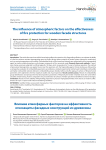
Статья научная
Introduction. The article discusses how artificial wood aging affects the retention of its fireproofing efficiency to evaluate the ability of a fire-bio-moisture-resistant impregnating agent to protect facing timber materials of facade systems exposed to weathering, such as varying temperature and humidity, if standardized levels of fire hazard and integrity are maintained and the impregnating agent has water-soluble phosphorus and nitrogen compounds of the nanoscale range. Research focus and methods. A specimen of pine wood was subjected to artificial aging for 120 days, which is equivalent to 15 years of outdoor operation. The method of pressurized impregnation was applied to pre-treat the specimen with the fireproofing agent. Climate testing was followed by a comparative evaluation of combustibility parameters according to a standard experimental method used to distribute combustible and hardly combustible materials between combustibility groups. Besides, before and after aging, all surfaces of fireproof wood specimens were subjected to thermo-analytical studies and visual inspection. Results and discussion. Results of combustibility group identification and principal thermal decomposition parameters of fireproof pine timber remained nearly the same before and after climate testing. Further comparative visual examination of surfaces of timber specimens identified no external changes. Conclusion. Research on the stability of fireproofing properties in pressure-impregnated timber shows that it can retain its effectiveness for up to 15 years under natural weathering conditions.
Бесплатно
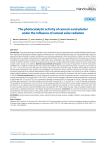
The photocatalytic activity of cement-sand plaster under the influence of natural solar radiation
Статья научная
Introduction. Concrete and cement composites can be considered as the most demanded and versatile building materials nowadays. Recently, photocatalytic building materials containing nano- and finely dispersed oxides and salts photocatalyst particles, especially titanium dioxide of anatase modification, are becoming widespread. Under the influence of light, the surface of these materials becomes capable of self-cleaning. The materials photocatalytic activity is usually determined in the laboratory conditions by irradiating samples with an artificial source of light with certain wavelength, which does not fully characterize the behavior of the material in real-life conditions. Therefore, the purpose of this study is to evaluate the photocatalytic activity of cement-sand plaster samples under natural solar radiation. Materials and methods of research. In this study, the properties of cement-sand plaster modified with an additive of industrial TiO2 were studied. The additive was introduced into the plaster compositions in amounts of 0.3; 1.0; 1.7; 3.0; 5.0 and 10.0 wt.% during the dry mixing of the components. At the first stage, the effect of the additive on physical and mechanical properties of the samples was investigated. The second part of the research is devoted to the study of the photocatalytic properties of the material. Mineralization of the model pollutant Methylene blue was carried out in real-life conditions under sunlight irradiation, the photocatalytic activity of the samples was evaluated in accordance with the European standard UNI 11259-2016. Results and discussion. As a result of the study, the authors found that the maximal increase in compressive and flexural strength corresponds to the sample with 5.0 wt.% of TiO2, and the maximum degree of Methylene blue decomposition corresponds to the sample with 10.0 wt.% of TiO2. Thus, compressive strength increases by 69% at 2 days age, by 58% at 7 days age, and by 50% at 28 days age compared to the control sample. Flexural strength increases by 10, 13, and 50% at 2, 7, and 28 days age, respectively. The strength of the samples with 10.0 wt.% of TiO2 remains approximately at the level of the control sample. Compositions with TiO2 starting from 3 wt.% demonstrate photocatalytic activity (R), the highest R corresponds to 10 wt.% sample with R value is 40–78%. It is also noticeable that the maximum Methylene blue mineralization (58–78%) is observed after 2 days of sunlight irradiation, after 7 days there is a significant decrease in the degree of pigment decomposition. Conclusion. As a result of the research, the authors concluded that the optimal amount of TiO2 photocatalyst in the cement-sand plaster is 5.0–10.0 wt.% since these samples exhibit maximum strength characteristics combined with a high ability of model contaminant degradation.
Бесплатно
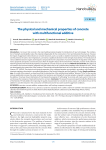
The physical and mechanical properties of concrete with multifunctional additive
Статья научная
Introduction. It is known that concrete is the main building material, despite the introduction of new technologies. The combination of strength and durability makes this material indispensable for the construction of civil and industrial infrastructure. However, the impact of aggressive external factors on concrete structures, such as an acidic or alkaline environment, temperature fluctuations, and the presence of water at low temperatures, can lead to a significant decrease in their strength characteristics. The introduction of various additives based on organic and inorganic compounds into the composition of concrete allows for the regulation of its performance properties and protect concrete structures from the negative impact of the environment. Therefore, research works aimed at improving physical and mechanical properties and quality of concrete structures are relevant. Methods and materials. The objects of our research were concrete samples, prepared with and without the use of a multifunctional additive called “Betomix-ITH Gel”, which was developed by the researchers of the Institute of Theoretical and Applied Mechanics of the Ural Branch of the Russian Academy of Sciences (ITC UB RAS). The physical and chemical properties of the compared samples were studied in accordance with Russian and interstate regulatory documents in accredited laboratories of the Russian Federation and the Republic of Turkey. Results and discussion. As a result of the research, we have found that the introduction of the multifunctional additive "Betomix-ITH Gel" to the concrete mixture significantly increases the water resistance, frost resistance, and strength of concrete samples, compared to samples without the additive. It has been shown that Betomix-ITH Gel imparts the property of "self-healing" to concrete, with cracks up to 0.5 mm in size, and increases the resistance of steel reinforcement to corrosion. Conclusion. The research has proved experimentally the effectiveness of the Betomix-ITH Gel additive for improving the quality characteristics for concrete of various classes, which allows the use of this additive in concrete mixtures in the construction of reinforced concrete structures located in aggressive conditions.
Бесплатно

Статья научная
Introduction. In the context of the global fight against climate change, the reduction of CO2 emissions and its utilization is a topical theme. One of the promising directions is the utilization of CO2 in construction, in particular, in concrete production. The present research investigates the effect of carbon dioxide on the formation of nanoscale structure and physical and mechanical properties of concrete mixtures. Methods and Materials. A special unit for mixing cement, sand, water and CO2 under pressure was developed for the research. The obtained concrete specimen were subjected to compressive and flexural strength tests using MATEST E161-03N automatic dual range testing press. The microstructure of the specimen was also analyzed using scanning electron microscope (SEM). Discussion. The experimental results showed that the introduction of CO2 into the concrete mixture promotes the formation of nanoscale structure, which improves its strength properties up to a certain pressure. With further increase in pressure, deterioration of these characteristics is being observed. Additional mixing time and increase in water volume also affect the strength of concrete and its microstructure. Conclusion. The use of CO2 in concrete production can significantly reduce the carbon footprint of construction materials and improve their physical and mechanical properties due to the formation of nanoscale structure. Further research and optimization of mixing parameters are necessary to create stronger and more stable concrete mixtures.
Бесплатно

The study of the formation of a hollow cellular structure with a given geometry
Статья научная
Introduction. The use of superplastic forming technology presents a number of challenges, including the lack of experimental and analytical data and the absence of specialized processing facilities. Another crucial factor limiting the widespread use of this methodology is the uniqueness and complexity of the equipment for performing the superplastic forming operation. The study is aimed at determining the optimal shape of the primary blank for the superplastic forming (SPF) process in order to obtain acceptable elongation of the bridges and minimal shrinkage. Methods and materials. Titanium alloy grade VT-6 was used as the material for obtaining the samples. The shape of the initial workpiece was optimized using a model sample, in which the ratio of the height and width of the fillets varied from 3:2 to 3:6 mm. The sample was obtained from a sheet 5 mm thick, by mechanical processing. The two halves of the sample were pre-welded together along the contour using argon-arc welding and sealed after pumping out the air from the cavity between them. Diffusion welding of the sample took place in an autoclave. The SPF was carried out in a limiting container at a temperature of 900±10 °C, argon was supplied according to the law ensuring optimal metal drawing in superplasticity modes. The width of the welded surfaces was from 2 to 4 mm. Modeling and finite element analysis of the SPF process were performed in the MSC Marc software package. The microstructure of the samples was studied using an Altami MET 1C microscope (with a USB 3.0 5 MPix camera). Results and discussion. The results of finite element analysis and a full-scale experiment of SPF are presented to verify the modeling results. During the research it was found that in order to minimize the depth of the resulting sink marks it is necessary to ensure an optimal ratio of the fillet radii equal to 3:5 and 3:6. The difference in the width of the platforms before SPF and the lintels formed after SPF was determined. The smallest narrowing of the lintels is characteristic of the widest platforms. Conclusion. The combined use of finite element modeling and a full-scale experiment made it possible to preliminarily identify the optimal ratio of the height and width of the outer fillet, which allows for acceptable elongation of the bridges and minimal shrinkage.
Бесплатно

